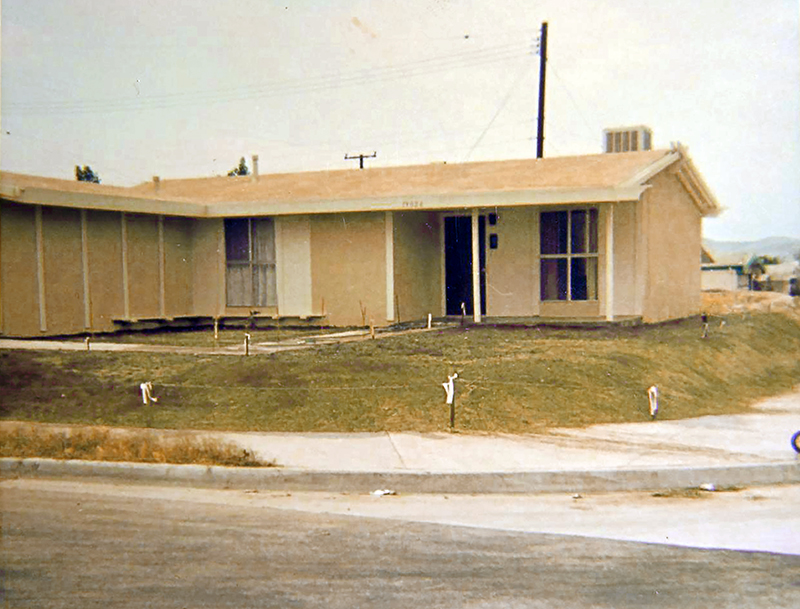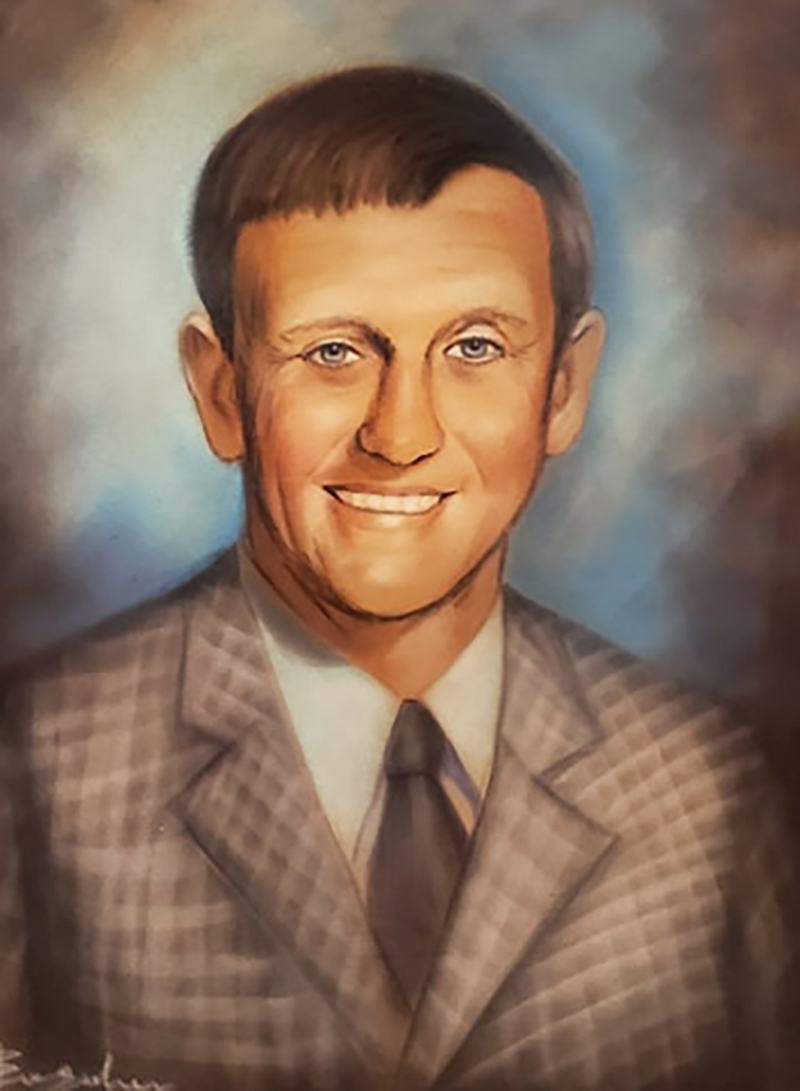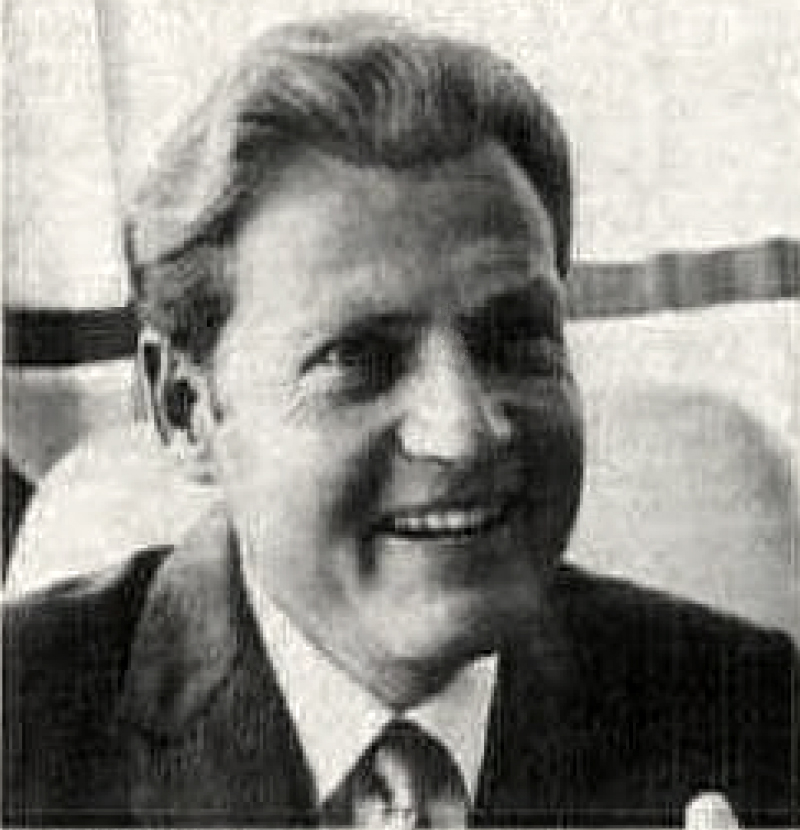Jerome Snyder School Office
North Oaks, Canyon Country, California

Jerome School Snyder office, a 3-bedroom, 2-bath home built in 1962 at 19026 Bagby Drive, corner Walnut Springs Avenue in the North Oaks community. Photo: 1966 (identified on back).
About the Snyder School. One of the more unusual public schools in SCV history would have to be the Jerome Snyder School in Canyon Country's North Oaks subdivision in the early 1960s. Intended to serve as a temporary campus until the new (second consecutive) Honby School could be completed at 19059 Vicci Street, the Snyder School didn't consist of portable classrooms — which weren't widely available then — or any other type of traditional school building. Instead, developer Jerome H. Snyder picked out a cul-de-sac in North Oaks' fourth phase, built 11 single-family homes on it, and loaned them rent-free[1] to the Saugus Union School District. (North Oaks was in the Saugus district until 1991 when it transfered to the Sulphur Springs district.) The cul-de-sac was Bagby Drive. All 11 original homes still exist in 2020. One of the 11 faces the cross street, Walnut Springs Avenue. Eight of the homes were used for classroom instruction, one as the school office (19026 Bagby Drive), one as a lunchroom and one as a "curriculum center."[2] The homes were purpose-built with interior walls and partitions omitted to the extent possible.[3] It was the third active school campus in the far-flung Saugus School District. The Snyder School pulled from North Oaks, Santa Clarita School in Seco Canyon pulled from the Bonelli tract, and the old Saugus School pulled everything else. School Organization. The Snyder School opened in September 1962 under the direction of Principal Leonard Gaylord, who came from the Covina Valley Unified School District and lived in Seco Canyon. Apparently 10 of the houses were used the first year, with four regular classes — first grade, second grade, and combined third-fourth and fifth-sixth grades — and two special education classes.[4]
All 11 houses were reportedly used the following year, and Snyder got a new principal in the person of Eugene Richard "Gene" Choppé, who evidently liked what he found there. According to The Signal, Choppé "cites such advantages as more square footage than in a normal classroom (and) two lavatories for each class. ... In addition, there is a field across the street where children play softball during P.E. periods. The entire cul-de-sac is fenced."[5] A bookmobile, or mobile library, jointly owned by L.A. County and the Saugus School District, made weekly visits on Wednesdays.[6] The attendance area was defined as "that part of North Oaks bounded by Whites Canyon Road on the east, Camp Plenty Road on the west, Pleasantdale on the south and Sky Blue Homes on the north. Also, the area bounded by Whites Canyon Road on the west, flood control channel on the south, and the Sulphur Springs School District on the east." No bus service was provided at first.[7] A Snyder School PTA (Parent Teacher Association) formed in 1963 with Marlene Best elected president. Officers were identified as Mrs. Jack Bost, Mrs. Fred Rio, Mrs. Robert White and Mrs. Sally Perry.[8] Not So Temporary. Construction was about halfway finished when the Honby School opened September 10, 1963.[9] Six years earlier, on December 17, 1957, voters in the Saugus Union School District passed a $300,000 construction bond measure by a margin of 101-1. (Yes, one.) Apparently the same (one) person also voted against another measure on the same ballot seeking $500,000 in state matching funds. There was one holdout; the "State Aid" measure passed by 100 votes to 1.[10] A two-thirds vote was all that was required. (Why state matching funds needed local voter approval is something we'll have to investigate.) But the opening of Honby didn't spell the end for the "temporary" Snyder School. The eastern stretches of Saugus, which weren't quite yet known by their new name of "Canyon Country," were growing. Next door to the east, the Sulphur Springs district quickly grew from one school to three with the addition of (the second) Mint Canyon Elementary in 1963 and Leona Cox in 1964. Children from the new Sunshine Homes tract in the Sky Blue area were assigned to the Snyder School for 1964-1965.[11] Now bus service was added. Still under Choppé, the teachers were Mrs. Dennis Adams, Mary Barnhouse, Esther Clark, Esther Custis, Margaret "Maggie" Eastman, Joyce King, Elizabeth Laurent and Gordon Sando. Eunice Walker taught the special education program, while two other special education teachers, Shirley Graessle and Jo Mayers, were transfered to Honby. In early 1965, the county was projecting an enrollment increase of 1,000 pupils for Saugus by the fall.[12] The school district floated a $2 million school bond measure — with a requested $18 million state match — in a May 25 election. It passed, 1,156-97. (The "State Aid" measure passed 1,153-98.)[13] If voter turnout is an indicator of population growth, that's a 10-fold increase in the number of ballots cast in eight years. With the approval, Saugus started construction on two new schools during the 1965-1966 school year: Skyblue Mesa (Sunshine tract) and Cedarcreek in North Oaks. For 1965-1966, kids from the Sunshine tract were shifted from Snyder to Honby, and bus service was canceled for Snyder.[14] Gene Choppé went on to lead larger schools in the Saugus district; taking the helm at Snyder was Harold Lockey[15], a kindergarten teacher at Honby the year before.[16] Finally, as the 1965-1966 school year ended, it was closing time for the cul-de-sac school that was intended to bridge a one-year gap but ultimately saw four years of service. Snyder's remaining attendance area shifted to Cedarcreek for 1966-1967,[17] and its 11 structures got a new lease on life as single-family homes. As for the Honby School, the Saugus district sold it in 1991 to the Sulphur Springs district, which renamed it Canyon Springs. Principal Gene Choppé died in 1976 at age 55. In the early 1980s, his son, Gary Richard Choppé, opened a local photography studio. Gary went on to serve as president of the SCV Chamber of Commerce in 1991 and as a Santa Clarita arts commissioner in the 2010s, and he assisted local charities for decades. Who is Jerome Snyder? Los Angeles real-estate developer Jerome H. "Jerry" Snyder was only 19 years old in 1949 when he started turning $1,100 and an eye for an opportunity into an 80-home subdivision in Garden Grove.[18] As of 2020, he heads a real-estate development company that builds luxury high-rises and office complexes in Los Angeles, and he runs a family foundation that endows cultural nonprofits in L.A. He also contributes to the Jules Stein Eye Institute and the School of Architecture and Urban Planning at UCLA.
Back in 1961, Jerry Snyder's company, Signature Development Co., teamed up with shopping center developer Pacific Coast Properties Inc. to build North Oaks. Under the deal, Pacific Coast was the landowner, Snyder/Signature was the developer-builder, and Signature became a wholly owned subsidiary of Pacific Coast with offices in Beverly Hills. (Pacific Coast Properties Inc. is unrelated to current business entities with similar names.) Snyder and partners unveiled their plans in early 1961 for a master-planned community — the SCV's first to call itself a "city" — of 2,000 homes and a 20-acre shopping center north of Soledad Canyon Road in Saugus (later called Canyon Country). Home sales were so brisk that in 1964, Pacific Coast purchased more land from the Schmidt family, whose shuttered 6-S Ranch Airpark sat astride Pleasantdale Street, for an additional 1,700 home sites (total 3,700). Simultaneously, Snyder and Pacific Coast were planning a senior community to the south, to be called Friendly Valley. After a series of delays in approvals from the county, the project opened in 1965. Maybe the delays were the cause, but whatever the reason, Pacific Coast reportedly showed losses for 1963-1965[19], so Snyder reorganized his Signature Homes Corp. and went solo again, purchasing $9 million worth of buildable residential real estate from Pacific Coast.[20] In 1969, operating as J.H. Snyder Inc., Jerry Snyder put his skills to work for Loew's Theatres, which by this time was widely diversified. For Loew's, Snyder developed single- and multifamily residential projects and shopping centers in population centers from San Francisco to Coronado.[21] J.H. Snyder Inc. grew into one of L.A.'s largest privately held real-estate development firms. According to the Los Angeles Business Journal, Snyder built "more than 40,000 homes across the county before turning to large office projects in the 1980s, such as the Wilshire Courtyard complex in mid-Wilshire, and retail lifestyle centers in the 1990s, such as the Promenade at Howard Hughes Center in Westchester."[22] The Wilshire Courtyard complex sits across from the 11-story SAG-AFTRA Plaza, where Snyder maintains his office after buying the building in 1978 and remodeling it. In a 2019 interview, Snyder named the 17-acre Water Garden financial campus in Santa Monica and the River at Rancho Mirage shopping center as two of his favorite projects.[23] Recent office projects include Hollywood 959, 1601 Vine and, under construction during the 2020 COVID-19 pandemic, the 21-story Wishire Curson apartment complex on L.A.'s Miracle Mile.[24] — Leon Worden 2020
1. The Signal, February 25, 1965. 2. The Signal, September 19, 1963. 3. The Signal, September 20, 1962. 4. Ibid. 5. The Signal, September 19, 1963. The principal's name was spelled "Choppee" here. 6. The Signal, January 17, 1963. 7. The Signal, May 23, 1963. 8. Ibid. 9. The Signal, August 29, 1963. 10. The Signal, December 19, 1957. 11. The Signal, August 20, 1964. 12. The Signal, February 25, 1965. 13. The Signal, May 27, 1965. 14. The Signal September 9, 1965. 15. The Signal April 24 1966. 16. The Signal, Sept 24, 1964. 17. The Signal, May 19, 1966. 18. Los Angeles Business Journal, March 8, 2019. 19. House & Home, Vol. 36 No. 1, July 1969. New York: McGraw-Hill Inc. 20. Ibid. 21. Ibid. 22. Los Angeles Business Journal, July 30, 2018. 23. Los Angeles Business Journal, March 8, 2019. 24. J.h Snyder Co. Builders and Community Developers [cq], at JhSnyder.net, accessed May 2020. Gene Choppé photo courtesy of Gary Choppé.
OX6601: 9600 dpi jpeg courtesy of Joan Oxman.
|


